WORKS FOR SALE
A PAIR OF SIX-FOLD BYŌBU (SCREENS) DEPICTING THE HORSE STABLE
W: 360cm
Further images
-
(View a larger image of thumbnail 1
)
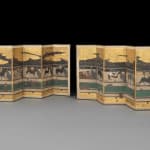
-
(View a larger image of thumbnail 2
)
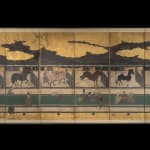
-
(View a larger image of thumbnail 3
)
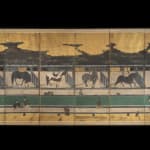
-
(View a larger image of thumbnail 4
)
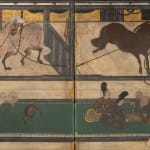
-
(View a larger image of thumbnail 5
)
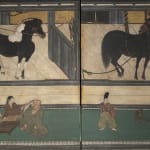
-
(View a larger image of thumbnail 6
)
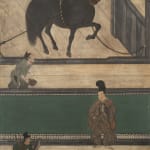
-
(View a larger image of thumbnail 7
)
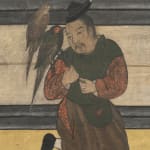
-
(View a larger image of thumbnail 8
)
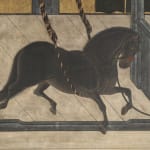
-
(View a larger image of thumbnail 9
)
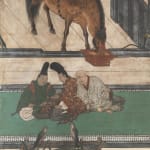
-
(View a larger image of thumbnail 10
)
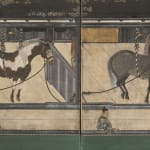
Provenance
On loan to the Art Institute of Chicago, September 1989 - September 1991
Private Collection: Europe
Exhibitions
Art Institute of Chicago, September 1989 - September 1991Literature
COMPARE:
Cleveland Museum of Art, Cleveland, Ohio, USA (1934.373), a nearly identical pair on which which the present screens were based
Tokyo National Museum, Tokyo, Japan (A-10139)
Imperial Household Agency, Tokyo, illus. Screen Paintings of the Muromachi Period: Kokka 100th Anniversary Exhibition (1989), cat. no. 35, pp. 106-7
SEE ALSO:
A pair of 17th Century screens sold Christie’s, 18 Sept 2008, USD 962,500
A pair of early 17th Century screens sold Christie’s, 28 March 2006, USD 968,000
A single late 16th early 17th Century sold Sotheby’s, 25 October 2023, GBP 482,600
A SUPERB AND RARE PAIR OF SIX-FOLD BYŌBU (SCREENS) DEPICTING A HORSE STABLE
This exceptional pair of six-fold screens (byōbu), dating to the transitional period between the late Momoyama and early Edo periods, Momoyama (1573–1615) – Edo period (1603–1868), circa 1600; presents a highly rare and richly detailed portrayal of a Japanese horse stable—not merely as a site of equestrian utility, but as a centre of courtly refinement, social gathering, and martial identity.
As one Western visitor observed with astonishment:
*“There was a stable above, wherein there were no more than five or six horses; but it was a stable only in name, because it was so clean and well kept that it seemed rather to be a fine chamber for the diversion of nobles than a place to lodge horses.”*¹
In contrast to European equivalents, Japanese stables of the late sixteenth and early seventeenth centuries were meticulously maintained, carefully designed, and often situated at the front of the residence, serving both a symbolic and practical role in samurai life. The ownership and display of fine horses were central to the power and social status of the samurai and daimyō classes, and the stable became a site of hospitality, entertainment, and spiritual significance.
As the Portuguese missionary Luis Fróis recorded in his 1585 work Striking Contrasts in the Customs of Europe and Japan:
*“In the homes of European nobility guests are first welcomed in the living quarters; in Japan their first reception takes place in the stables… Our stables are always behind or in the lower part of the house; in Japan, they are built at the front of the house.”*²
Built of sugi (Japanese cedar)—the sacred wood used in Shinto shrines and Buddhist temples—these stables reflected the revered role of horses in Japanese belief. Horses were understood to be messengers of the gods, capable of affecting the weather and bridging the human and divine realms.³
An Animated Equestrian World
The horses across the two screens are depicted with vivid individuality and energy. In the upper screen, tension and vitality prevail: a horse rears, another bucks violently, while a dappled steed tosses beside a groom sweeping the floor. Others stand watchful and spirited. In contrast, the lower screen has a more serene rhythm: a horse bows to eat from a trough, another reclines on a straw mat, and two central horses, one skewbald, stand composed in rest.
The artist’s attention to detail extends to mane styles, where six horses wear the karihoshi (“shaved priest”) style, tied at intervals with rice straw, and others are shown with nogami, or free-flowing “field hair.”⁵ The use of straw, far from humble, symbolised fertility and abundance.⁶ Anatomically, the horses are rendered with short legs, elongated torsos, and sensitive brushwork that conveys strength, weight, and the natural curve of musculature. Several are secured with harakeke ropes around their bellies, a method used to help horses sleep while standing.⁷
Scenes of Social Life
Beyond the stalls, the screens come alive with human activity. In adjoining tatami-matted spaces, samurai and courtiers recline in discussion, monks and nobles play go, sugoroku, and shōgi, a falconer tends to birds, and grooms and attendants move fluidly through the space—working, resting, conversing. Small dogs roam freely, while a tethered monkey, believed to ward off horse illness, is gently handled by a young tamer.
These genre elements, finely painted and carefully staged, speak to the social significance of the stable—a space in which class boundaries softened, and a shared cultural interest in horses, games, and status united different groups.
Rarity and Comparisons
The survival of a pair of screens of this subject, quality, and condition is exceedingly rare. Equestrian subject matter, particularly depictions of interior stable scenes, appears only in a very limited group of known examples. These screens are closely related to a slightly earlier pair in the Cleveland Museum of Art (1934.373), dated to the late Muromachi period (1392–1573). They share identical stall scenes and similar groupings of visitors, though differ in the sequence and composition of panels. Notably, while the Cleveland pair is topped with a misty gold-leaf cloud band, the present screens are overlaid with scalloped gold clouds, reflecting the Momoyama period’s taste for opulence and brilliant surface decoration.
Further related examples include a single-stable screen in the Tokyo National Museum (A-10139), and another in the collection of the Imperial Household Agency, Tokyo.⁸ The present pair was on loan to the Art Institute of Chicago from 1989 to 1991, underscoring their international importance and past exhibition history.
In their animated portrayal of horses, precise genre detail, and richly symbolic staging, these screens offer a rare and culturally significant vision of the Japanese stable—not merely a physical structure, but a ceremonial and social heart of elite samurai life. Their exceptional state of preservation, rarity of subject, and historic resonance mark them as one of the finest surviving examples of this genre.









